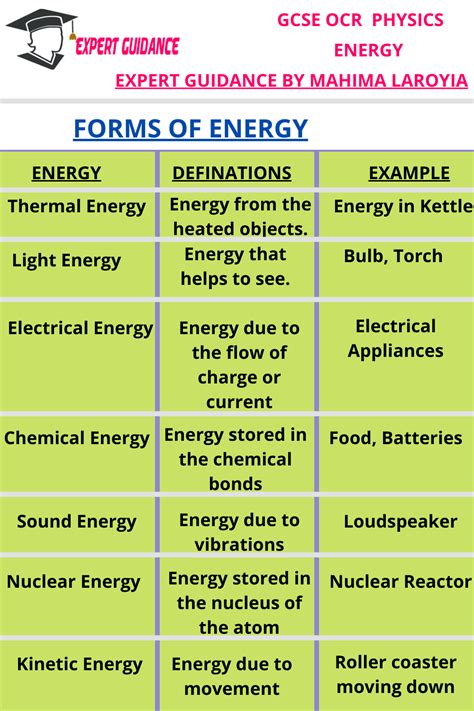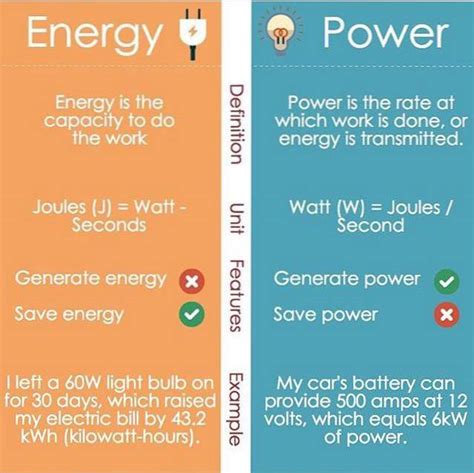When discussing energy and power, it's essential to understand the distinction between these two fundamental concepts in physics. Energy and power are often used interchangeably, but they have different meanings and implications. In this article, we'll delve into the differences between energy and power, exploring five key aspects that highlight their unique characteristics.
Understanding Energy and Power: Definitions and Distinctions

Energy refers to the capacity to do work, which can be in various forms such as kinetic energy, potential energy, thermal energy, or electrical energy. On the other hand, power is the rate at which energy is transferred or converted from one form to another. In other words, power is the amount of energy used or produced per unit time. To illustrate the difference, consider a car engine: the energy stored in the fuel is converted into kinetic energy, which propels the car forward, while the power of the engine determines how quickly the car accelerates.
1. Energy as a Measure of Capacity
Energy is a measure of the capacity to perform work, and it can be quantified in units such as joules (J) or kilowatt-hours (kWh). The amount of energy available or required to accomplish a task is a critical factor in determining the feasibility of a project. For instance, the energy required to power a smartphone for a day is relatively low, typically around 10-20 kWh, whereas the energy required to power a entire household for a day can range from 20-50 kWh or more.
| Energy Type | Unit of Measurement |
|---|---|
| Kinetic Energy | Joules (J) |
| Electrical Energy | Kilowatt-hours (kWh) |
| Thermal Energy | British Thermal Units (BTU) |

2. Power as a Measure of Rate
Power, on the other hand, is a measure of the rate at which energy is transferred or converted. It is typically quantified in units such as watts (W) or kilowatts (kW). The power required to perform a task is critical in determining the time it takes to complete the task. For example, a high-power drill can drive screws faster than a low-power drill, even if both drills have the same energy capacity.
The relationship between energy and power is given by the formula: Power (P) = Energy (E) / Time (t). This formula highlights the inverse relationship between power and time, meaning that as power increases, the time required to complete a task decreases, and vice versa.
3. Energy Efficiency and Power Consumption
Energy efficiency refers to the ratio of useful energy output to the total energy input. It is a critical factor in determining the overall performance of a system or device. Power consumption, on the other hand, refers to the amount of power required to operate a device or system. A device with high energy efficiency will typically consume less power than a device with low energy efficiency, even if both devices have the same energy capacity.
For instance, a LED light bulb with high energy efficiency may consume only 9 watts of power to produce the same amount of light as a traditional incandescent bulb that consumes 60 watts of power.
4. Energy Storage and Power Generation
Energy storage refers to the ability to store energy for later use, while power generation refers to the process of producing energy from various sources such as fossil fuels, nuclear, or renewable energy sources. The ability to store energy is critical in addressing the intermittency of renewable energy sources, such as solar or wind power, which are dependent on weather conditions.
Advances in energy storage technologies, such as batteries, have enabled the widespread adoption of renewable energy sources, reducing our reliance on fossil fuels and mitigating climate change.
5. Energy Policy and Power Infrastructure
Energy policy refers to the set of principles and regulations that govern the production, distribution, and consumption of energy. Power infrastructure, on the other hand, refers to the network of systems and facilities that enable the generation, transmission, and distribution of electricity. A well-designed energy policy and power infrastructure are critical in ensuring a reliable and efficient supply of energy to meet the growing demands of modern society.
Key Points
- Energy refers to the capacity to do work, while power is the rate at which energy is transferred or converted.
- Energy efficiency is critical in determining the overall performance of a system or device.
- Power consumption is a critical factor in determining the cost and environmental impact of energy use.
- Energy storage is essential in addressing the intermittency of renewable energy sources.
- A well-designed energy policy and power infrastructure are critical in ensuring a reliable and efficient supply of energy.
In conclusion, understanding the differences between energy and power is essential in developing efficient systems and technologies that can meet the growing demands of modern society. By recognizing the unique characteristics of energy and power, we can design and implement more effective solutions that promote energy efficiency, reduce power consumption, and mitigate the environmental impacts of energy use.
What is the difference between energy and power?
+Energy refers to the capacity to do work, while power is the rate at which energy is transferred or converted.
Why is energy efficiency important?
+Energy efficiency is critical in determining the overall performance of a system or device, and it can help reduce power consumption and mitigate the environmental impacts of energy use.
What is the role of energy storage in renewable energy systems?
+Energy storage is essential in addressing the intermittency of renewable energy sources, such as solar or wind power, which are dependent on weather conditions.



